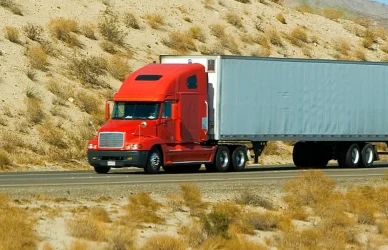For years, the trucking industry has faced a labor shortage in their driving workforce. However, fleets are now discovering a growing demand for support roles that keep operations running seamlessly. From dispatchers to platform supervisors, these back-office jobs are critical to ensuring everything runs efficiently. And let’s not forget about the crucial tech support that keeps the entire operation humming! Without these positions, even the best truck drivers can’t succeed. Find out why the demand for support roles is on the rise in the trucking industry.
IT is a highly sought-after job category in the back office, says Richard Armstrong, the chairman of Armstrong & Associates – a leading third-party logistics consulting firm.
“I’m sure that more and more people being hired in the back office will be college graduates,” he said.
“All of these roles are difficult to fill at brokerages and trucking companies; they are always behind the hiring curve because of how variable the market really is. The challenge becomes getting good people in and getting them trained effectively and quickly for roles that are not revenue generating,” said Ryan Schreiber, chief growth officer with Metafora, a technology consultant specializing in transportation and logistics, based in Chicago.
“Companies are looking to save money. The back office is often seen as a cost center, and largely it is. Additionally, there are typically a number of upstream issues in sales and operations that create issues in the back office. However, it is also mission critical. Without timely and accurate billing, trucking and logistics companies face serious cash flow issues,” Schreiber added.
Many companies are experiencing more stability in hiring back-office workers. According to Sarah Statlander, VP of human capital and talent acquisition at Yellow, the LTL carrier has not been affected by a hiring downturn for operations leadership positions during or since the pandemic. Additionally, Greg Richardson, VP of HR at Estes Express Lines, confirms that their nearly 7,000 back-office employees are in a stable work environment. These employees perform crucial functions that serve as “the glue that holds everything together.”
“They are our planners, our coordinators; they are the transactional folks that position our freight in the right place to allow the drivers to execute the great work that they do,” Richardson said. “Theirs are essential functions and roles within our organization, and any dip in labor numbers or volatility with hiring drastically limits our ability to service our customers.”
Estes is currently receiving a healthy amount of job applications, according to Richardson. Although they still utilize traditional recruitment methods to attract external candidates, the company has also established a successful technique for increasing the number of applicants through their employee referral program.
“We get really great employees who know other really great people who are looking for really great jobs; we are trying to leverage that,” he said.
As a key architect of Estes’ employee referral program, Sara Graf, VP of Sustainability, Culture, and Communications emphasizes effective communication to bring the company’s culture to life. “We’re a family-inspired culture, and we want to make sure that comes through in everything we’re sharing,” she said, adding that communication often starts at their career webpage.
“We also do a variety of hiring events, in person and virtual, and partner with local organizations,” she said. “We’ve done things with tech schools, community colleges, veterans’ organizations and workforce centers to get the word out.”
Social media plays a vital role in communicating information about available jobs.
“One of our aspirations is to be a leading place to work,” said Jason Turner, vice president of talent and growth initiatives for ArcBest, an integrated logistics company. This year, the company is celebrating a major milestone – its 100-year anniversary, and it is utilizing the milestone as part of its hiring strategy, emphasizing the company’s longevity and connecting this to the longevity of employees.
ArcBest offers an enticing employee referral program that rewards workers with a monetary bonus for referring successful job candidates. Similar to Estes, this program incentivizes current employees to recommend qualified individuals for open positions.
Turner believes these programs are effective because, “When someone refers someone else, there’s a little more accountability.”
In addition to referrals, Turner said that the company “fishes in many channels” to find the best candidates for back-office positions, from such digital methods as LinkedIn and Indeed, to establishing relationships with community colleges. “We’re emphasizing the military and transitioning service members; this is very important for us as well,” he said.
Statlander agreed that the beset way to find talent is to be proactive. “Gone are the days of posting a position and thinking people are going to apply. We have to go out and search and hunt and make sure we are finding the right talent,” she said. “It takes lots of work to refine our recruitment process to identify the right skills and capabilities. With this labor market, candidates are interviewing us as much as we are interviewing them.”
The flip side to recruitment is retention, and this often proves to be the greater challenge.
“The ones that are doing more and leading the charge are investing in things like training and education for their people, developing their people into better professionals and showing folks that they’re really invested in their growth as individual professionals,” said Schreiber.
To retain employees and ensure their growth, Estes Express’ Richardson emphasizes the significance of upward mobility. The company focuses on recruiting individuals who are career-oriented and capable of filling various roles. Richardson himself started as a dockworker and climbed the ranks to become the vice president of human resources. Focus on developing your employees and they may just surprise you with their potential.
“We have training initiatives to elevate people to a different level in their career,” he said. “A dockworker can be elevated to a dock supervisor, for example.”
Yellow’s Statlander reports that the company has made significant efforts towards employee retention in recent years. These initiatives encompass drivers, dockworkers, and supervisors.
“Communicate. Make sure new hires understand the requirements of the job,” she said. “The terminals and locations that really place emphasis on that are the places we have seen great improvement in terms of our retention, and dispatchers are a big key to that.”
Connecting with drivers and dockworkers is crucial, and she stressed the significance thereof. Engaging with them regularly is key to establishing a solid relationship and a deeper understanding of each other’s work.
“We’ve read studies that drivers will leave if they don’t feel like they are being respected or listened to,” Statlander said. “Our dispatchers and dockworkers are a big key in that relationship.”
Effective training and leadership development are crucial factors for retaining employees, as observed by Statlander.
“We have a robust supervisor onboarding program that we launched in the last year,” Statlander said, adding that Yellow has an apprenticeship program that provides on-the-job training.
At ArcBest, employee growth is a top priority according to Turner. Their focus lies in providing developmental opportunities to their team members, ensuring that they can build a fruitful career with them.
“There are hundreds of people annually that are promoted across our company,” he said, adding the goal is to create a good work life with camaraderie and a family atmosphere.
Back-office work is a promising field with a bright future ahead according to industry experts. There is a steady demand for jobs in this industry, making it a great career option.
“I think technology and the use of data will continue to reshape the jobs, which will continue to be more enriched by the availability of real-time data; this will make the job itself different but it will continue to be needed,” said Turner. “Human skills will continue to be more in demand as technology augments and supports the roles themselves.”
Schreiber agrees that the development of technology will not replace people but help “to augment their ability to work more effectively and increase the metrics the company cares about,” he said.
Richardson believes that security in the positions is another reason why back-office workers are flocking to these roles. “There are very few scenarios where any levels of technology will replace the extremely valuable work our back-office workers do. That work is so vitally important, and so transactional,” he said.
According to Statlander, the demand for drivers, dockworkers, and field leadership is expected to remain constant.
“I think from an industry perspective, especially for us in our portion of the industry, we’re going to continue to see those front-line supervisor roles continues to have an importance,” she added. “That will be an ongoing effort for us as many companies in the industry address that situation of getting younger people exposed to and interested in a career in trucking.”
Source: Transport Topics











